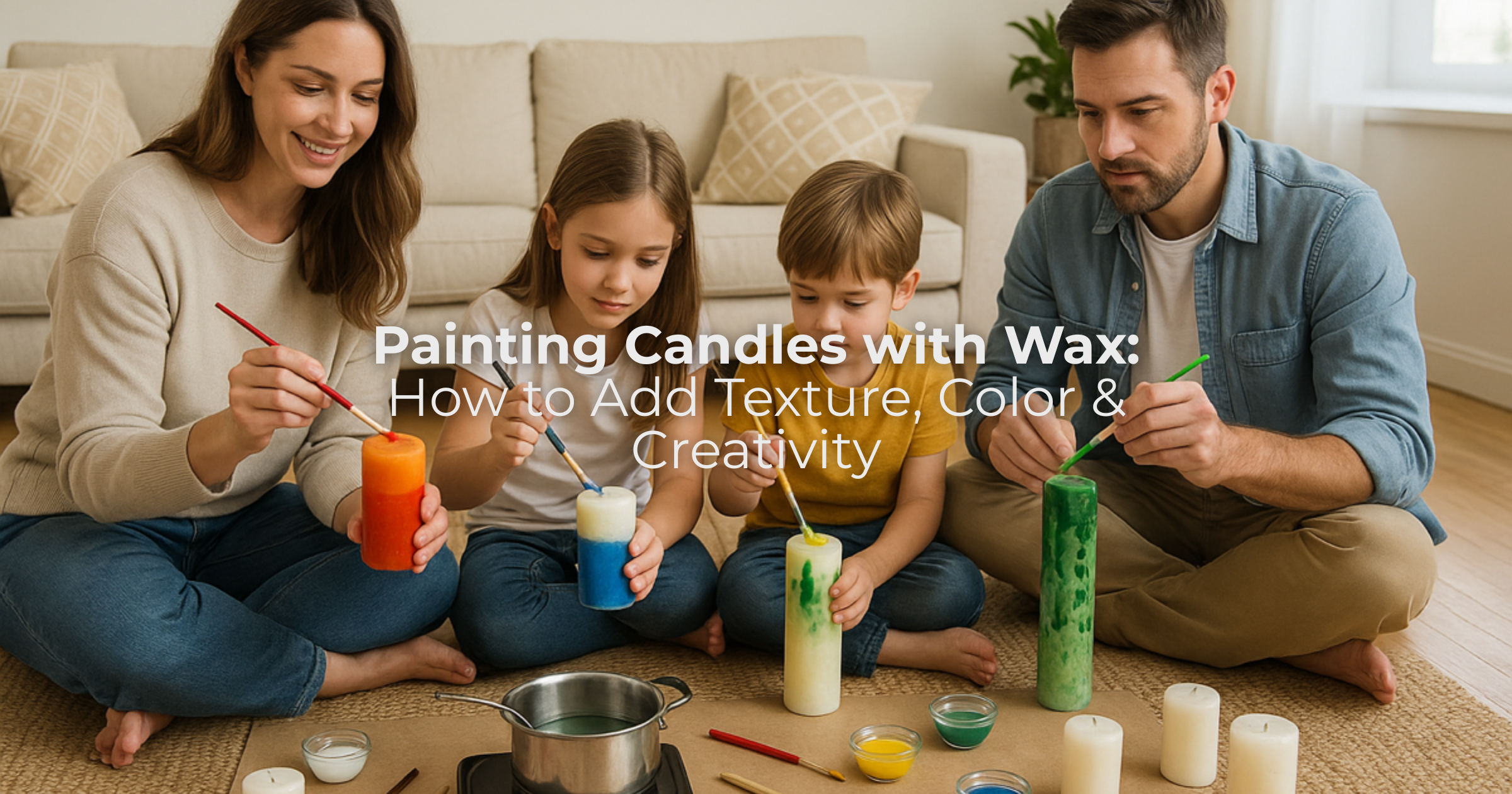No products in the cart.
Painting Candles with Wax: How to Add Texture, Color & Creativity
- Nav Preet
- No Comments

If you’ve ever admired the soft, hand-crafted texture on designer candles and wondered how it’s made, this guide will show you exactly that.
In this blog, we’ll explore painting candles with wax, a creative method where melted, colored wax becomes the paint itself. You’ll learn the complete wax painting process, from melting and coloring wax to layering and sealing it for a smooth finish.
Whether you’re a beginner or an experienced candle maker, this tutorial will help you understand how painting a candle with melted wax transforms ordinary candles into artistic pieces that hold color, texture, and personality far better than traditional paints.
What Does Painting Candles with Wax Mean?
Unlike painting on candles, painting candles with wax means using melted, pigmented wax as the medium itself. You melt colored wax and apply it to finished candles to decorate or accent specific areas.
This approach draws from encaustic painting, an ancient technique in which heated beeswax, mixed with pigments, creates textured, enduring art.
Warm wax flows like paint and, as it cools, hardens into ridges, waves, or soft brush marks. You can even reheat spots to merge layers, a flexibility most paints lack.
Because wax bonds naturally to wax, the design doesn’t peel or crack, making it ideal for decorative, display, or gift candles.
This process suits all types of smooth soy pillars, paraffin jars, or rustic beeswax tapers. It’s more than decoration; it’s integration.
Each stroke merges color and form, turning a simple candle into expressive, durable art that reflects the maker’s craft.
What Materials Are Needed to Paint Candles with Wax?
The wax painting process starts with proper materials. Use clean, smooth candles made from paraffin, soy, or beeswax.
Each reacts differently: paraffin gives a glossy coat, soy a matte softness, and beeswax a warm, natural tone.
Prepare small batches of melted wax mixed with candle dyes or pigments. Melt leftover wax chips in a double boiler and stir in dye flakes or color blocks until smooth.
Avoid acrylic or paint pigments they can interfere with bonding or burning.
Essential tools include:
- A double boiler or wax melter for safe, even heating.
- Heat-safe containers to mix colors.
- Fine brushes or spatulas for applying layers.
- Protective gloves and a heat-resistant workspace.
Your wax texture should feel silky and pourable, thick enough to hold shape yet smooth enough to brush.
Once you find that balance, painting candles with wax becomes intuitive, giving you precise control over color and texture.
How to Paint a Candle with Melted Wax?
When you work with melted wax, timing and temperature define everything. I’ve divided this process into simple, proven steps you can follow safely at home.
1. Melt the Wax Safely
Start by melting the wax slowly using a double-boiler setup. Never apply direct heat, as it can cause the wax to burn or smoke. The goal is a smooth, lump-free liquid.
The ideal wax melting temperature typically stays between 65°C and 80°C, depending on the wax type. Stir gently to keep the texture even.
As the wax liquefies, you’ll notice its transparency change; that’s when it’s ready to take on pigment. Always work in small batches so you can control texture and color density easily.
2. Add Color Pigments or Dyes
Once melted, stir in wax dyes or oil-based colorants. Powder pigments disperse beautifully when mixed at a consistent temperature.
I prefer blending multiple shades to achieve depth. For example, a soft coral base with a layer of burnt orange gives a candle subtle transitions when light hits it.
Maintain a balanced wax-to-pigment ratio. Too little pigment leads to dull tones, while too much can make the surface flaky. Mix until the color looks even and saturated.
Remember, wax appears darker when liquid, so test a small drop on paper and let it cool before finalizing your palette.
3. Apply Melted Wax on Candle Surface
Now comes the creative part. Using a fine brush or small spatula, apply the colored wax to your candle surface. Move in short strokes or gentle swirls to build layers.
You can create marbled textures by dripping wax from different heights or use a heating tool to blend colors directly on the candle.
For raised designs, allow each layer to cool slightly before applying the next. This gives structure and prevents smudging.
If you prefer a blended, gradient look, keep your workspace warm enough for slow cooling around 25°C to 30°C. At this temperature, the wax settles naturally without harsh edges.
What makes this process special is its forgiving nature. If something goes wrong, you can always reheat and reshape the wax.
It’s fluid art that lets you experiment freely until your design feels complete.
4. Seal and Smooth the Wax Layer
Once you’re happy with the design, seal the surface for a refined finish. Lightly warm the candle’s outer layer using a heat gun or hair dryer on a low setting.
This melts micro imperfections and fuses your painted wax into a single, polished layer.
Don’t overheat, as it can distort your texture. I’ve found that a few seconds of gentle warmth is enough to create that smooth, glass-like finish. The result is a stable, durable surface that won’t peel or crack.
Let the candle rest at room temperature for several hours. This curing phase helps the wax structure stabilize, ensuring your art lasts longer even when stored or used decoratively.
Final Thoughts
Painting candles with wax is more than a craft; it’s a creative dialogue between color, texture, and warmth.
By mastering the wax painting process, you can turn plain candles into expressive art that feels both personal and lasting.
Each brush of melted wax adds character and depth that ordinary paint can’t match.If you love handcrafted design, explore candles from Karigar Style, where every piece reflects the same artistry, care, and timeless beauty inspired by wax painting itself.

Nav Preet is the founder and creative soul behind Karigar Candles. Inspired by heritage, nature, and the warmth of handmade artistry, she crafts candles that do more than glow—they evoke emotion. Through this blog, she shares her love for scents, styling, and mindful living, one flame at a time.
Creative Head at Karigar Style







